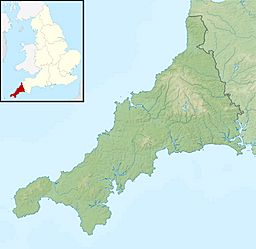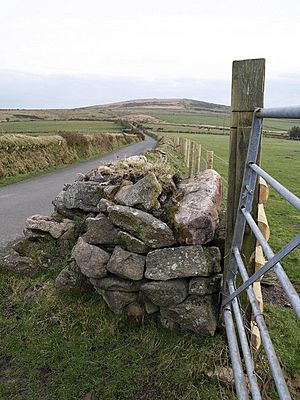Brown Gelly facts for kids
Quick facts for kids Brown Gelly |
|
|---|---|

Brown Gelly Cairn
|
|
| Highest point | |
| Elevation | 342 m (1,122 ft) |
| Prominence | 74 m (243 ft) |
| Parent peak | Brown Willy |
| Listing | Tump |
| Geography | |
| Location | Bodmin Moor, Cornwall, England, UK |
| OS grid | SX196727 |
| Topo map | OS Landranger 201 |
Brown Gelly is a special place in Cornwall, UK. It's a type of rocky hill called a tor, and it also has a long, narrow top part known as a ridge. You can find Brown Gelly on Bodmin Moor, which is a large area of open land near Liskeard. It's also close to a famous lake called Dozmary Pool.
Brown Gelly is not just a natural landmark; it's also a place with a lot of history. The land around its base, called Browngelly Downs, holds many clues about people who lived there long, long ago.
Contents
Discovering Brown Gelly
Brown Gelly is a fascinating spot on Bodmin Moor. It's known for its unique shape and the ancient secrets it holds.
What is Brown Gelly?
Brown Gelly is a combination of different landforms. It's a tor, which means it's a large, free-standing rock outcrop that has been shaped by nature over time. It's also a hill, rising above the surrounding land. The top part of Brown Gelly is a ridge, which is like a long, narrow hilltop.
Ancient History and Remains
The area around Brown Gelly is like an open-air museum, full of ancient structures. You can find several types of old remains here:
- Hut circles: These are the stone foundations of very old homes where people lived thousands of years ago. They show us where prehistoric villages might have been.
- Barrows: These are ancient burial mounds, often shaped like large hills of earth or stone. They were used to bury important people.
- Cairns: These are piles of stones, often built by people for various reasons, like marking a burial site or a special place.
Along the ridge of Brown Gelly, there are five cairns arranged in a curve. They are easy to see from far away. Some experts, like Christopher Tilley, think these cairns were placed there to look like the natural tors, especially when viewed from the east or west. This might have been a way for ancient people to connect their creations with the natural landscape.
The Rocks of Brown Gelly
The tor at Brown Gelly is made of a type of rock called granite. Granite is a very common and strong rock. What's interesting about the granite here is that it hasn't changed as much as granite in other parts of Bodmin Moor. This is because of something special about the local area that protected the rock from a process called autogenic alteration, which is when rocks change due to chemical reactions within themselves.
Looking for Clues from Above
In the 1980s, archaeologists used aerial reconnaissance to study the area. This means they flew over the land in planes and took pictures. These pictures helped them spot patterns on the ground that suggested there was a prehistoric settlement. This settlement was made up of several hut circles spread out across the land. Some people have also called these groups of structures a "barrow group."
Old Industries: Flint and Tin
More evidence of ancient life at Brown Gelly comes from discoveries of flint and tin.
- Flint production: Flint is a hard stone that ancient people used to make tools and weapons. Finding evidence of flint production means people were making these tools right here.
- Tin streaming: This is an old method of finding tin, a valuable metal, in rivers and streams. The presence of tin streaming suggests that people were mining and processing tin in the area a very long time ago.
All these findings, from the hut circles to the flint and tin, support the idea that Brown Gelly was once home to an active ancient community.



